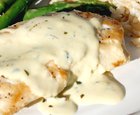|
French Entree Chicken with Mustard We offer two versions of this wonderfully piquant chicken dish—one oven-baked with a mustardy crust...the other sauteed and topped with a creamy mustard sauce.
Heat oven to 375. In one bowl mix mustards and pepper. In a second bowl beat eggs. In a third bowl, add breadcrumbs. Coat chicken with mustard (a brush is helpful), dip in eggs, then in breadcrumbs. Make sure all sides are coated. Arrange in baking pan and dot with butter. Bake for 25-30 minutes, till juiced run clear when pricked with a fork. Remove from heat and allow chicken to sit for 5 minutes. Serve hot or cold. _______________ Sauteed * You can use a combination of smooth and course-grained mustards. |
Tips & Glossary Bouquet Garni: (boo-kay gar-nee) bundle of herbs tied together with string or wrapped in cheese cloth square; usually parsley, thyme, bay leaf, and peppercorns. Flavor is released during long cooking.Remove before serving. Chervil: (sher-vil) related to parsley but has a delicate anise flavor. Long cooking kills flavor, so add at the last minute. Cornichon (kor-nee-shon) teeny-tiny pickle, served with pates & smoked meats; found in specialty food stores. Fines Herbes: (feen-airb) mix of finely chopped herbs: parsley, chives, tarragon, & chervil. Not as strong as a bouqet garni. Buy it at most grocery stores. Fromage: (fra-mahj) Cheese! The French eat more than any nationality, 45 pounds per capita per year; and the country makes more cheeses than any other country, about 400. Herbes de Provence (airb-duh-pro-vonce): mix of dried herbs, usually thyme, rosemary, marjoram, basil, & bay leaf Can be found at most grocery stores. Mutarde: (moo-tard), mustard. Most famous: Nicoise Olive: (nee-swaz- oh-leev) small, purplish-black olive with a mellow, nutty flavor; used primarily in Salade Nicoise. The Picholine variety is a green, medium-sized olive with a light, nutty flavor. Roux: (roo) paste-like mix of melted butter and flour, into which liquid is gradually added. The basis of every classic French sauce.
|
Site by BOOM
![]()
LitLovers © 2024

